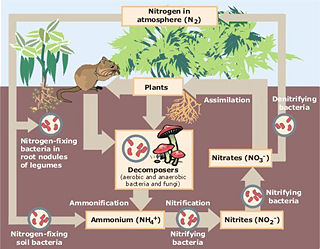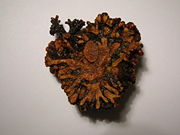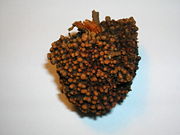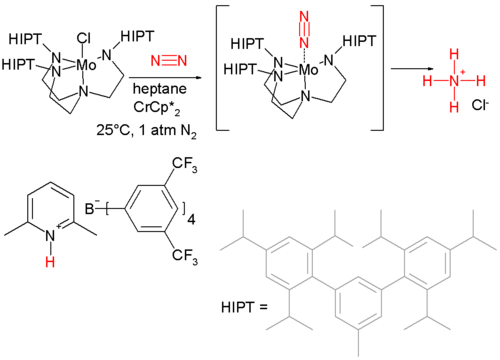Nitrogen fixation
2008/9 Schools Wikipedia Selection. Related subjects: Biology; Chemistry
Nitrogen fixation is the process by which nitrogen is taken from its natural, relatively inert molecular form (N2) in the atmosphere and converted into nitrogen compounds (such as ammonia, nitrate and nitrogen dioxide).
Nitrogen fixation is performed naturally by a number of different prokaryotes, including bacteria, actinobacteria, and certain types of anaerobic bacteria. Microorganisms that fix nitrogen are called diazotrophs. Some higher plants, and some animals (termites), have formed associations with diazotrophs.
Nitrogen fixation also occurs as a result of non-biological processes. These include lightning, industrially through the Haber-Bosch Process, and combustion.
Biological nitrogen fixation was discovered by the Dutch microbiologist Martinus Beijerinck.
Biological nitrogen fixation

Biological Nitrogen Fixation (BNF) occurs when atmospheric nitrogen is converted to ammonia by a pair of bacterial enzymes called nitrogenase. The formula for BNF is:
- N2 + 8H+ + 8e− + 16 ATP → 2NH3 + H2 + 16 ADP + 16 Pi
Although ammonia (NH3) is the direct product of this reaction, it is quickly protonated into ammonium (NH4+). In free-living diazotrophs, the nitrogenase-generated ammonium is assimilated into glutamate through the glutamine synthetase/glutamate synthase pathway.
In most bacteria, the nitrogenase enzymes are very susceptible to destruction by oxygen (and many bacteria cease production of the enzyme in the presence of oxygen). Low oxygen tension is achieved by different bacteria by: living in anaerobic conditions, respiring to draw down oxygen levels, or binding the oxygen with a protein such as Leghemoglobin - also spelled leghaemoglobin..
The best-known plants which contribute to nitrogen fixation in nature, are in the legume family - Fabaceae, which includes such taxa as clover, beans, alfalfa, lupines and peanuts. They contain symbiotic bacteria called rhizobia within nodules in their root systems, producing nitrogen compounds that help the plant to grow and compete with other plants. When the plant dies, the fixed nitrogen is released, making it available to other plants and this helps to fertilize the soil The great majority of legumes have this association, but a few genera (e.g., Styphnolobium) do not. In many traditional and organic farming practices, fields are rotated through various types of crops, which usually includes one consisting mainly or entirely of clover or buckwheat (family Polygonaceae), which were often referred to as "green manure", since the other natural way of adding nitrogen to the soil is via animal waste products. The entire plant is often ploughed back into the field, thus not only adding more nitrogen, but also improving the soil's organic content and volume.
Non-leguminous nitrogen-fixing plants
Although by far the majority of nitrogen-fixing plants are in the legume family Fabaceae, there are a few non-leguminous plants that can also fix nitrogen. These plants, referred to as actinorhizal plants, consist of 22 genera of woody shrubs or trees scattered in 8 plant families. The ability to fix nitrogen is not universally present in these families. For instance, of 122 genera in the Rosaceae, only 4 genera are capable of fixing nitrogen.
Family: Genera
Betulaceae (Birch): Alnus (Alder)
Cannabaceae: Trema
Casuarinaceae (she-oaks):
- Allocasuarina
- Casuarina
- Gymnostoma
- Casuarina
Coriariaceae: Coriaria
Datiscaceae: Datisca
Elaeagnaceae (oleaster):
- Elaeagnus (silverberry)
- Hippophae (sea-buckthorn)
- Shepherdia (buffaloberries)
- Hippophae (sea-buckthorn)
Myricaceae:
- Morella arborea
- Myrica
- Comptonia
- Myrica
Rhamnaceae (buckthorn):
- Ceanothus
- Colletia
- Discaria
- Kentrothamnus
- Retanilla
- Trevoa
- Colletia
Rosaceae (rose):
- Cercocarpus (mountain mahogany)
- Chamaebatia (mountain misery)
- Purshia (bitterbrush or cliff-rose)
- Dryas
- Chamaebatia (mountain misery)
There are also several nitrogen-fixing symbiotic associations that involve cyanobacteria (such as Nostoc). These include some lichens such as Lobaria and Peltigera:
- Mosquito fern ( Azolla species)
- Cycads
- Gunnera
Microorganisms that fix nitrogen
- Diazotrophs
- Cyanobacteria
- Azotobacteraceae
- Rhizobia
- Frankia
Nitrogen Fixation by Cyanobacteria
Cyanobacteria inhabit nearly all illuminated environments on Earth and play key roles in the carbon and nitrogen cycle of the biosphere. Generally, cyanobacteria are able to utilize a variety of inorganic and organic sources of combined nitrogen, like nitrate, nitrite, ammonium, urea or some amino acids. Several cyanobacterial strains are also capable of diazotrophic growth. Genome sequencing has provided a large amount of information on the genetic basis of nitrogen metabolism and its control in different cyanobacteria. Comparative genomics, together with functional studies, has led to a significant advance in this field over the past years. 2-oxoglutarate has turned out to be the central signalling molecule reflecting the carbon/nitrogen balance of cyanobacteria. Central players of nitrogen control are the global transcriptional factor NtcA, which controls the expression of many genes involved in nitrogen metabolism, as well as the PII signalling protein, which fine-tunes cellular activities in response to changing C/N conditions. These two proteins are sensors of the cellular 2-oxoglutarate level and have been conserved in all cyanobacteria. In contrast, the adaptation to nitrogen starvation involves heterogeneous responses in different strains.
Chemical nitrogen fixation
Nitrogen can also be artificially fixed for use in fertilizer, explosives, or in other products. The most popular method is by the Haber process. This artificial fertilizer production has achieved such scale that it is now the largest source of fixed nitrogen in the Earth's ecosystem.
The Haber process requires high pressures and very high temperatures and active research is committed to the development of catalyst systems that convert nitrogen to ammonia at ambient temperatures. Many compounds can react with atmospheric nitrogen under ambient conditions (eg lithium makes lithium nitride if left exposed), but the products of such reactions are not easily converted into biologically accessible nitrogen sources. After the first dinitrogen complex was discovered in 1965 based on ammonia coordinated to ruthenium ([Ru(NH3)5(N2)]2+), research in chemical fixation focused on transition metal complexes. Since that time a large number of transition metal compounds that contain dinitrogen as ligand have been discovered. The dinitrogen ligand can be bound either to a single metal or bridge two (or more) metals. The coordination chemistry of dinitrogen is rich and under intense study. This research may lead to new ways of using dinitrogen in synthesis and on an industrial scale.
The first example of homolytic cleavage of dinitrogen under mild conditions was published in 1995. Two equivalents of a molybdenum complex reacted with one equivalent of dinitrogen, creating a triple bonded MoN complex. Since this triple bounded complex has been used to make nitriles . The first catalytic system converting nitrogen to ammonia at room temperature and 1 atmosphere was discovered in 2003 and is based on another molybdenum compound, a proton source and a strong reducing agent. Unfortunately, the catalytic reduction only undergoes a few turnovers before the catalyst dies.
In contrast to the graphic shown above, the major product of this reaction is ammonia (NH3) and not an ammonium salt ([NH4][X]). In fact, approximately 75% of the ammonia produced can be distilled away from the reaction vessel (suggesting the ammonia is not protonated) into a vessel containing HCl as a trap. This method of trapping the NH3 was doubtlessly chosen because it makes the product easier to handle. Also, note that because only 1 equiv of Cl anion is available under catalytic conditions (via reduction of the precatalyst molbdenum chloride, shown) therefore it is unlikely that the product ammonium salt would always have this counterion.
Note also that although the dinitrogen complex is shown in brackets this species can be isolated and characterized. Here the brackets do not indicate that the intermediate is not observed.


